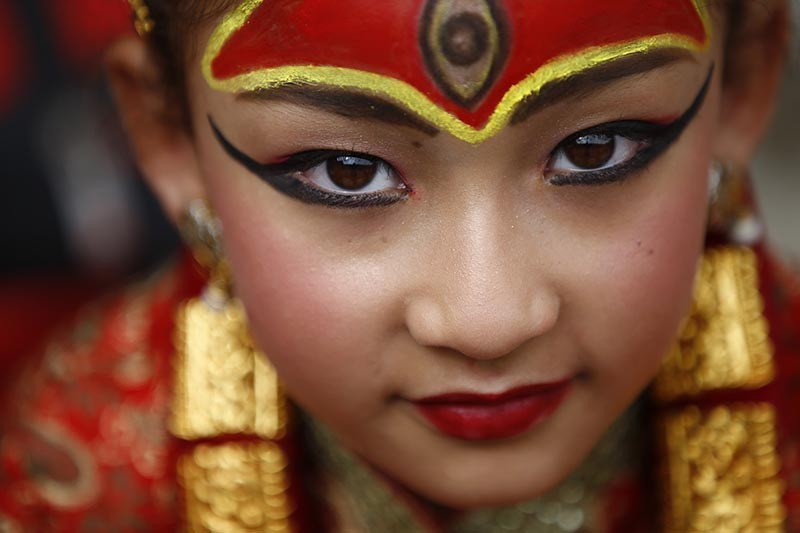
Maybe it’s just me, but had anyone else never heard about the living goddess in Nepal? We learned about this beautiful and centuries old tradition during our first walking tour of Kathmandu and I can’t stop reading about it…
Nepal is the only place in the world where there exists a “living goddess,” called the Kumari. It is a little girl, chosen through a very selective process, as the embodiment, the manifestation of a specific Hindu goddess. There are several Kumaris throughout Nepal – often one per major town or area of the country – but in Kathmandu, there sits the Royal Kumari.
Kumari is seen as the living reincarnation of the goddess Taleju. There are many legends and stories Nepalese use to explain the origins of the living goddess – one of the more prevalent is that the goddess Taleju used to visit former King Jaya Prakash Malla for intellectual discussions and to play games…then on one visit, the King made sexual advances towards her and infuriated the goddess, so she disappeared as a punishment. After the king prayed for her return, the goddess agreed to return in the body of a virgin girl from the Shakya caste and the tradition began…
We were fortunate enough to be on a walking tour with a senior guide who brought us into the courtyard of the Kumari’s temple…and we saw her!!! You could feel the excitement of the locals as this adorable little 5 year old walked to the window, looked down on the masses silently, and then went back inside. The Kumari is widely seen as a symbol of “good luck” if you see her. You are NOT allowed to take pictures of her when she appears at this balcony and they were very strict about that. The only time people can photograph her is when she leaves the temple for the festivals and rituals she attends.
As we learned, Hinduism and Buddhism are more closely intertwined in Nepal than in other places in the world – many locals have trouble identifying themselves with only one of these religions and the Kumari is a reflection of that. She is worshipped both by Hindus and Buddhists. Chosen by Buddhist priests but worshipped by both groups. She comes from a Buddhist family but is seen often as a Hindu goddess.
So who is the Kumari? How do they choose this mysterious little girl?
She is always a pre-pubescent girl chosen from a specific caste in Nepal – the Shakya caste of the Newari clan in Nepal. The current Royal Kumari was chosen when she was only 3 years old which isn’t at all uncommon. These girls remain the Kumari until they hit puberty and then it is seen that the goddess has left them because they are no longer clean and virginal. The selection process is vigorous, particularly as it involves a very, very young child. Senior Buddhists priests, a royal astrologer and others participate. She must be in excellent health, never had any diseases or “spilled any blood” and must not have lost any teeth yet. She cannot have any blemish on her body – an examination is done for the final candidates. There is a list of 32 characteristics of a goddess that they look for – like “eyelashes like a cow,” or “neck like a conch shell.” Her disposition must be serene and she must display fearlessness, often tested (per rumor at least) through seemingly frightening rituals involving sacrificed animal heads. (!!)
The daily life of the Kumari also fascinated me. The Royal Kumari lives in a specific place in Kathmandu – Durbar Square – completely away from her family. She only comes out of the temple she lives in for specific festivals and ceremonies and those are only approximately once a month. She is otherwise expected to participate in rituals and other ceremonies, receive “petitioners” who give offerings and make requests of the goddess. She has a team of caretakers that stay in the temple with her and are responsible for all aspects of her care. She has specifically chosen playmates from certain castes and private tutors come to her for schooling in the temple. She is always dressed in red, has the same hair and makeup. Her feet can never touch the ground until the goddess leaves her body and she is no longer the Kumari – so anytime she leaves for festivals, she must be carried or on her beautifully made up chariot.
So what happens to the Kumari when she’s “done?” She just goes back to normal civilian life. Most former Kumaris, in interviews, say this is very challenging. There are also superstitions that the Kumari can’t marry. Many men in Nepal are superstitious of marrying a former Kumari because legend says the man will meet his demise as soon as he does.
I could write pages and pages about this but if this interests you at all, check out some great articles about it on NatGeo and NPR!

